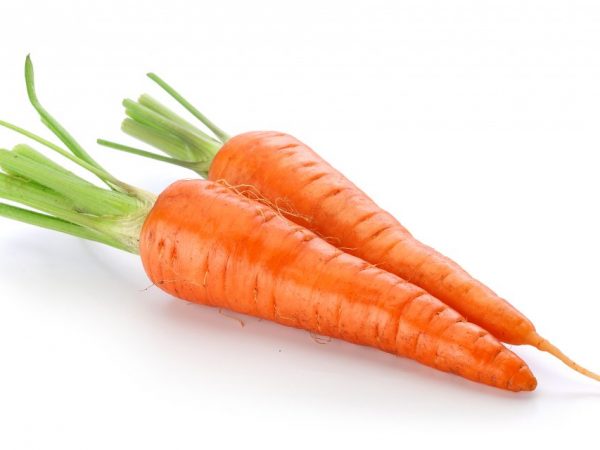Description of the variety of carrots Queen of autumn
One of the late-ripening varieties with positive characteristics is the Queen of Autumn carrot.

Description of the variety of carrots Queen of autumn
Variety characteristic
The Queen of Autumn carrot variety belongs to the late ripening, its growing season lasts up to 130 days. The crop is harvested in early October, even if the seeds were sown in June. Root crops are able to withstand winter, retaining their taste and marketability even at temperatures of -4 ° C.
The variety is high-yielding: from 1 sq. m are harvested from 3.5 to 9 kg of vegetables. Productivity largely depends on the fertility of the soil. Even under unfavorable growing conditions, the average yield is 5 kg / sq. m.
Description of carrots
According to the description, the Queen of Autumn carrot has a spreading leaf rosette, short light-green leaves. The shape of the roots is conical, elongated, with a slightly rounded end. Their length varies between 20-30 cm, weight varies from 100 to 250 g. Fruits are orange, not quite saturated, color.
The pulp of root vegetables is dense, juicy, has a rich sweetish taste. It contains a large amount of carotene - an average of 20 g - and a record amount of sugars - about 11%. Carrots are suitable for preparing fresh salads, preserving, making juice.
Advantages and disadvantages of the variety
The queen of autumn carrots have many positive qualities, but they also have disadvantages.
Advantages:
- high productivity;
- unpretentiousness to growing conditions;
- resistance to cracking;
- disease resistance;
- resistance to flowering in conditions of short daylight hours;
- long shelf life - about 8 months, up to a new harvest;
- high taste and usefulness.
Disadvantages:
- dull color;
- uneven sizes;
- the difficulty of extracting long carrots from dense soil.
Negative characteristics are insignificant, so this variety is grown not only by gardeners, but also by large agricultural producers for sale and for industrial purposes.
Features of agricultural technology

Characteristic cracks on carrots
The Queen of Autumn variety sometimes cracks, has a bitter taste or small size. This usually happens due to non-compliance with any growing rules.
Choosing a place for sowing
The seeds are sown on flat areas. It is important that the sowing site is not flooded and is not in lowlands. The culture loves sunlight, so the garden area should be well lit. Due to poor lighting, the crop will be small, with poor taste, and the yield will be significantly reduced.
The soil for growing carrots should be light, loose, fertile, and permeable. It must also have good drainage properties. Clay and sandy soils are not suitable, because even after fertilization they will not give a good harvest. The ideal option is black soil.You can create loose soil yourself by mixing compost, sand and garden soil.
Preparing the beds
Before sowing the seeds, the site must be dug up, with a rake they break up all the earthen lumps. This is done so that the vegetables grow even. Due to the dense caked earth and large lumps or stones, the roots are bent.
The crop grows well in high, flat-topped beds. Their height should be within 15-20 cm. Seed holes are made on the tops of the beds. The distance between them should be at least 15 cm: this makes it easier to care for the crop.
Sowing seeds
Seeds are usually sown at the end of May to harvest at the end of September. In the southern regions, sowing takes place in early summer and harvesting in October. Before sowing, the seeds are soaked in warm water for 2-3 hours so that they sprout faster. Then the soaked seeds are wrapped in a wet cloth to swell. During the day, they increase and become suitable for sowing.
Carrot seeds are small. In order not to thicken the landing, they should be combined with sand in a 1: 2 ratio. This sowing method is the most optimal, but there are others: sowing with paste and gluing the seeds to toilet paper. The seed holes should be no more than 1 cm deep. First, they are watered with water, then seeds are placed in them, sprinkled with earth and slightly compacted.
Crop care
In order for root crops to grow and develop well, it is necessary to care for them from the moment the seeds are sown. The soil should always be moist, therefore, sprinklers are installed in the hot season.
Make sure that watering is moderate: due to the large amount of water, root crops will crack. The number of waterings is reduced after the appearance of the first leaves. In dry weather, the crop is watered 3-4 times a week. Humidification is not required during the rainy season.
To get large fruits and high yields, the beds are periodically thinned out. The first procedure is carried out with the appearance of 3 full leaves, the second - when the roots are as thick as a pencil. The distance between vegetables after thinning should be 3 and 5 cm, respectively. After the procedure, the beds must be watered.
Disease and pest control
The Queen of Autumn is resistant to almost all diseases and pests. However, it sometimes rot after rainy periods. To prevent its appearance, they adhere to the rules of crop rotation. After harvesting, the site is not sown with carrot seeds for 1-2 years. They also make high beds: moisture does not stagnate in them, so the roots do not rot.
Among the pests for this variety, the carrot fly is dangerous. Under its influence, root crops grow poorly, and their root collar becomes reddish-purple. To avoid the attack of the parasite, the beds are regularly loosened, make sure that water does not stagnate in them and that the crop is always in the light. If the carrot fly has already attacked the plants, it is fought with the help of special insecticides.
Conclusion
Among all varieties of carrots, the Queen of Autumn is appreciated for its high yield, unpretentiousness, resistance to diseases and pests, and high marketability and taste. Adhering to the basic rules of agricultural technology, it is easy to get a high-quality crop.


